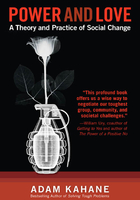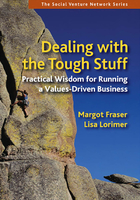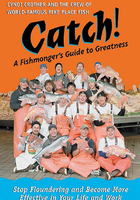Your Biggest Problem at Work and the Most Unexpected Solution
We all want to be successful, effective, happy people. That’s probably one of the most common desires in adult humans. We want to contribute in a meaningful way. We want to enjoy our friends, family, and colleagues; make money; and feel good about our work and life. And these are great desires; they keep us striving, keep us motivated and engaged—keep us living.
But what about the problems we face in reaching those goals? It sometimes feels as though we’re paddling upstream and that the very things we want to enjoy and rely upon—such as good teams and relationships, challenging projects, and a successful career—just aren’t coming together.
The surprise I will explore in this book is that our issues and problems aren’t actually about spreadsheets. Or cash flow. Or the economy, clients, salespeople, or even the boss. It certainly feels as if those things are the root of all the frustration, worry, and sleepless nights—and they are a part of it, certainly. But the most important factor underlying all of these elements is trust.
That’s right, trust. And if that seems startling, get ready for an even bigger surprise.
The key to creating trust and success in the workplace is probably the last thing you would ever imagine. It’s improvisation.
Improv. Like the club you visited in Chicago. Like Whose Line Is It Anyway? on TV. Like good jazz.
Improvisation, along with the skills and behaviors that are the breath and blood of improvisers, is the surest way to start working at a higher level, creating high-performance teams, exhibiting greater leadership behaviors, and building and engendering trust at work.
image The model for management that we have right now is the opera. The conductor of an opera has a very large number of different groups that he has to pull together. The soloists, the chorus, the ballet, the orchestra, all have to come together—but they have a common score. What we are increasingly talking about today are diversified groups that have to write the score while they perform. What you need now is a good jazz group.
PETER DRUCKER[1]
Let’s take some time to think a bit more deeply about trust.
The level and amount of trust you feel affect not only your own performance but also the performance and profitability of your entire organization. Trust in yourself, trust in your team, trust in your boss, and trust in your organization.
We build trust over time, through consistency and behaviors that continually show we are collaborative, innovative, and, well, trustworthy. We have to earn trust through our behavior, and that takes work, because trust is seriously low among us right now. We don’t trust our banks, we don’t trust our politicians, we don’t trust our dry cleaner, and we sometimes don’t trust ourselves. This is a serious national issue.
People love to invoke the “good old days,” in part because there seems something innocent and rosy about the period one hundred years ago. People then believed that a man’s word was his bond. There seemed to be fewer reasons to doubt certain institutions. But then scandals arose, individuals lied, and governments broke their own laws. So now, when we desperately want to just live, to just get through our days, we feel compelled to double check everything: check another newswire, check another reference, check to see if we got enough change back. It’s exhausting, time consuming, and saddening, and when we do decide to trust someone or something as a matter of principle, we walk away worrying “Will I be glad or made a fool?”
One of the biggest holes in our ability to trust has to do with our teams and organizations. When we don’t trust our colleagues or don’t believe that our company has our best interests in mind, we end up without foundational trust. Corporate confidence is at an all-time low as a result of a long wave of shameful activities: Enron’s ethical morass, Madoff’s lies, Wall Street’s collapse, GM’s bailout, and the list goes on. It has made us cautious, sad, and slow to trust.
The irony here is that the financial collapse came out of too much trust. Most people do not understand the complexities of finance and real estate, so we trusted our financial and real estate institutions and the individuals doing the work to be ethical. We trusted that they would work in a collaborative way that would take into account the greater needs of the market and the country, always looking for a way for everyone to come out ahead. Instead, they acted only on their own behalf, did not collaborate with other entities, and lost track of the big picture.
I’ve encountered some people who doubt the critical importance of collaborative behaviors. Over the twenty years I’ve been doing my work, a lot of people have tried to convince me that, professionally, trust shouldn’t matter.
“Plow through! If you’re a professional, it shouldn’t matter if you like or trust other people! Just get it done!” I’ve actually heard those words come out of a manager’s mouth. I doubt his team enjoyed working for him.
When trust is low, people experience stress, which seriously affects our health, mental capabilities, and emotional stability. Daniel Goleman, the researcher behind the concept of emotional intelligence, tells us “stress makes people stupid.” He states that people cannot “remember, attend, learn, or make decisions” when they are emotionally upset—when they’re worried, frustrated, angry, or hurt.[2]
Have you ever felt any of those emotions at work? The experience of emotional stress creates physical side effects such as higher blood pressure, stomach and intestinal issues, headaches, weight gain or loss, and lower metabolism. We also suffer mentally. We more easily lose control of our temper, we can’t prioritize as well, we lose our ability to process rationally, and our memory does not work as well.
All of these emotional and physical side effects result from the stress generated by any environment that keeps us from working together effectively. When people are constantly wondering whether they can share information, if they have to watch their backs, or if their colleagues don’t value them, the result is low trust.
Conversely, when trust is in place, it creates incredible strength in individuals, teams, and organizations. Relationships stay strong in an atmosphere of respect. Teams over-perform when they collaborate and trust that everyone is working toward a common goal. Leaders motivate when followers trust that those leaders are competent and ethical. Organizations thrive when there is trust in the adherence to goals and values. And for that matter, customers buy products because they trust the quality of a brand name. Planes take off because pilots trust that the engineers, air traffic controllers, and ground technicians have done their jobs. And we stay in relationships when we trust that we will be cared for.
As Patricia Aburdene wrote in Megatrends 2010, “Transcendent values like trust and integrity literally translate into revenue, profits, and prosperity.”[3]
Radical collaboration creates trust. And trust is the key to relationships, teamwork, leadership, and success. So how do we create trust, engage in trustworthy behaviors, and start to reap those personal and professional benefits?
The Most Unexpected Solution You’d Ever Guess
Improvisers step onstage without a script, set, costumes, makeup, or props. They arrive without any of those common tools of theater—and yet, they perform. They create scenes, relationships, comedy, even complete one-act plays on the fly.
Great improv is a lot like deep trust. There’s an overwhelming misconception that trust is something that either exists in a relationship or doesn’t, that it can’t be learned, changed, or built. In the same way, many people believe that improvisers must be born with a special set of skills—skills that either you have or you don’t.
Another type of improvisation occurs in jazz. Improv is the departure of a musician from the written music. Imagine that a jazz group is playing a song it has rehearsed and then the saxophone player suddenly begins a solo that’s never been written, that she’s never played before, and that the rest of her group have never heard. She’s creating something entirely in the moment, based on the energy of the room and her own inspiration. Her band members are going with it, listening and contributing a bass line, a riff on the piano, or a faster snare beat based on what they hear from the soloist. At the time, none of them knows how long the solo will go, how much they’ll contribute, or if it will turn into a duet. They make it all happen in the moment.
That’s improvisation.
Considering that the number one adult fear is public speaking, even when delivering a prepared speech, improvisation may sound to some people like a personal horror movie.
“That’s impossible,” you’re thinking. “I don’t think anyone could do that. Besides, this is an utterly foreign concept to me. I can’t improvise! How could improv possibly make a difference at work?”
But guess what. You do improvise. Every single day. Although a quick wit and sense of humor help professional improvisers enormously, they don’t have unreachable skills that no one else can learn. As a matter of fact, just like any profession, improvisation has a process, a set of skills, and guidelines for success.
When your boss calls you into her office and asks you to work on a project you’ve never heard about, one that sounds completely scary, and you say, “Sure, I’d be happy to work on that,” you’re improvising.
When you’re presenting to a big client and she asks a question you’ve never considered, and you nod and start to answer, then get some support from your partner in the room, you’re improvising.
When a critical team member is out sick and you’re covering his work while finishing your own, all while pitching in on a surprise proposal that unexpectedly came through the door, you’re improvising.
Anyone can improvise, and anyone can learn to collaborate on an extreme level. Improvisers collaborate radically—their level of trust and the intensity of their work are far above and beyond normal teamwork. That sort of behavior is the key to building, managing, showing, and engendering trust. Strangely enough, these concepts are intertwined in a surprising way. Improvisational troupes can’t perform well without trust, but trust can’t occur unless our behaviors and words show that we are trustworthy. This is true of every group of people who interact, especially in work situations. We can’t do our work well, collaborate, or grow if we cannot trust that everything from our basic needs to our ideas is in trustworthy hands. Sound like a circle? It can be, and how we choose to behave determines whether the circle spins backward or forward.
Improvisation and the Workplace
Here’s a real situation we encountered with a client a few years ago. We got a call to work on a branding initiative. From the outside, it looked like a very straightforward engagement. Two huge banking entities were merging and the joint leadership was smart enough to realize that they wanted a clean new brand and message (rather than the mashed-up combo you normally see after a merger). The brand message was key; it had to identify what the new organization stood for and its value in the market. The company’s leaders also realized that if the organization’s employees didn’t understand and embrace the new identity it could create confusion for the market.
This was a complicated problem, but not a complex one. Atul Gawande is a writer who researches how we get things done. He contends that complicated problems are difficult, but once they’re figured out, they can be solved the same way over and over. Like the bank’s leaders, we approached this as a complicated problem. Using a brand image, sales models, workshops, charts, and graphs, we could implement a solution that would be applied ubiquitously.
In collaboration with a marketing strategist, we created a workshop to be rolled out to hundreds of people, ranging from the CEO to the administrative assistants, in two different markets. However, after completing the first workshop, we realized this job wasn’t going to be about branding at all. We were stopped in our tracks.
The organization’s presenting issue, its own diagnosis of its symptoms, was uncertainty about its organizational identity and poor communication. “Presenting issue” is trainer speak for the behavioral issues that block effective work, and the things that people do and say that create conflict and waste time, money, and resources. And this diagnosis was partly right. There were obvious problems in how the people from the two banks were communicating, which was making everyone leery about their postmerger identity.
But the real, deeper problem only made itself apparent after my ensemble arrived. The banking teams did not trust each other. These people were worried, suspicious, and stressed. They lived and worked in two very different cultures and often misunderstood their new colleagues. They had never collaborated or worked together in a way that allowed them to build trust!
This was a complex problem rather than a complicated one. In a complex problem, outcomes are highly uncertain. These people were exhibiting unexpected emotions, reactions, and concerns. They could not be presented with a one-size-fits-all solution; they had to be dealt with as individual, complex people with particular concerns.
This is what we saw: People in the wealth management branch of the company were worried that their new colleagues wouldn’t understand how to manage high-net-worth clients and would weaken their high-profile brand. People on the retail end of the business were offended that their new colleagues treated them with disdain when the retail business was actually bringing to the new organization far more reach and product diversification. In addition, these two groups came from very different parts of the United States: the wealth management group from New York City and the retail branch from the Midwest. Each group made jokes, rolled eyes, and expressed frustration with the other group.
For these people, the situation represented quite a vicious circle: poor communication → no collaboration → misunderstanding → low trust → more guarded communication → lower trust. And on it went.
The lack of collaboration and trust within the organization was leading to a terrible waste of resources and loss of time, money, growth, and innovation. The associates needed to collaborate immediately to meet multiple merger deadlines. Misunderstandings led to inappropriate work product, which led to constant revisions, late nights, and frazzled employees.
I worked closely with one woman in New York who told me that she worked from 9 a.m. to midnight every day. She was living in a hotel and hadn’t seen her husband in a week because “there’s no one else who can do this. I can’t trust anyone in the other market to get it done right, and if this work doesn’t happen, it would be disastrous to the merger.”
At the same time, a man in the Midwest market was spending hours on the phone and in research because “they’re not sharing everything we need. It’s as if they don’t want to work with us. They don’t want to trust us! Every time I go back, I get new information. If they would just share it in the first place, I wouldn’t be spinning in circles.”
In addition, managers were trying to protect their own employees against unavoidable layoffs. Rather than collaborating with their new colleagues, working together to assess the best talent, and creating the right team, they were protecting turf. I spoke to one manager who resented her counterpart in the other city: “We’ll both keep our jobs, but she’s getting to keep a lot more of her people than I am just because she’s working this politically. My people are better, but they’re getting laid off because she’s pulling strings!”
In the case of the bank merger, my ensemble had to say something. We talked extensively with leadership about reworking this program. We spoke up about the issues we saw, and we asked to address and record merger issues and to allow the participants to brainstorm solutions. They would know more about their regional cultures, would have in-depth solutions from the field, and people would feel ownership of the new brand and culture of the organization.
With our client’s OK, we took action. We retooled the debrief points to address the stress these people were feeling, and added specific exercises to teach collaboration and adaptability. The new workshops gave the employees a forum to talk about the merger and tried to give them a place to look at all sides of the issue. Management actively participated. The merger, the activities related to it, and the level of stress had been unexpected. These workshops focused on enabling the participants to have mentally freeing moments in which they could visualize an outcome and brainstorm about the actions needed to get there. Ideas for growth and greater cultural and brand identity were collected from both markets and then shared across the new enterprise to smooth the transition to a single, merged organization.
image Few things can help an individual more than to place responsibility on him, and to let him know that you trust him.
BOOKER T. WASHINGTON[4]
And trust slowly began to improve. The understanding generated by the aggregated information enabled the teams to collaborate more efficiently. Their entrance into a merged organization was easier because they applied the behaviors of radical collaboration.
If you are working in a place that feels like that bank before the merger, it’s time to flip this paradigm. It’s time to change how we work, behave, and communicate, because when people do feel trusted and engage in trustworthy behaviors, they feel good. They feel motivated and they want to contribute not only their best effort but also their discretionary effort. That’s when people go above and beyond, by their own choice, putting in extra time and work because they are committed to success, and it makes such a difference for teams and organizations. Those improvisational behaviors build flexibility, collaboration, positivity, and trust.
The Four Secrets of Improvisation
Improvisation works because of certain principles—secrets, really. Improvisers can accomplish amazing things because they understand these secrets, and if we can learn to apply some of those improvisational secrets to life and work, we too can build trust and accomplish amazing things. This book explores four of the most important secrets of improvisation that create trust: Yes! Space, Building Blocks, Team Equity, and Oops to Eureka!.
The concepts are quite simple. Yes! Space is a way for us to bring positivity and creativity into the workplace. Building Blocks enables us to take something small and build it into something exceptional. Team Equity shows us how to leverage the combined power of the people in our organizations. And finally, Oops to Eureka! helps us to understand that the unexpected often yields the greatest discoveries.
There are a lot of great books out there that delve deeply into the definition of trust. If you want to tear apart the subject of trust, subdivide trust into types, and get really academic about it, I recommend you check those out.
This book is about learning and practicing new behaviors and ways to communicate that are radically collaborative and that show and build trust. Those behaviors are based on the principles of improvisation. Let’s take a close look at how improvisation can inform our ability to collaborate and trust, and why it is so special.
notes:
[1]. Peter Schwartz and Kevin Kelly, “The Relentless Contrarian,” Wired, August 1996.
[2]. Daniel Goleman, Emotional Intelligence: Why it Can Matter More than IQ (New York: Bantam), 149.
[3]. Patricia Aburdene, Megatrends 2010: The Rise of Conscious Capitalism (Charlottesville, VA: Hampton Roads Publishing, 2005), xiv.
[4]. Booker T. Washington, Up from Slavery: An Autobiography (New York: The Country Life Press, 1900).














